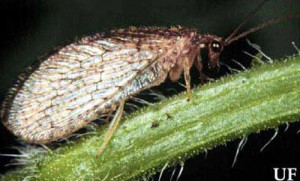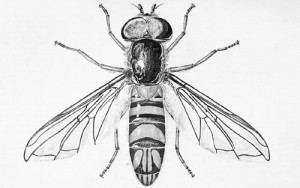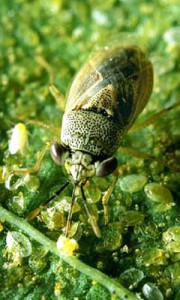This spring, most garden plants are putting on lots of tender new growth. The lush foliage is like a free lunch to aphids, whiteflies, mealybugs and thrips. Before broad spectrum insecticides are used to control these pests, consider the impact on beneficial insects. Insecticides that don’t measurably harm predatory beneficial insects include insecticidal soaps and all season horticultural oils, which kill soft-bodied insect pests at application. Here are several common beneficial predatory and parasitic insects that help keep the pests at bay.
Assassin Bug Zelus longipes
Assassin bugs are predators of several leaf feeding and sap sucking insects including the fall army worm and the Asian citrus psyllid. They trap their prey by holding onto it with their forelegs and secreting enzymes into the prey to dissolve the interior tissue. Then they ingest the dissolved tissue.
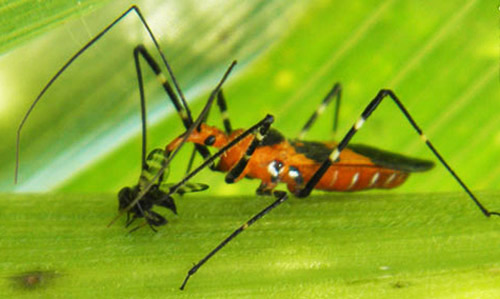
Adult female milkweed assassin bug, Zelus longings Linnaeus, feeding on a cornsilk fly, Euxesta stigmatias Loew. Credit: Megha Kalsi, University of Florida
Lady Bug or Lady Beetle
These insects most commonly feed on aphids, most insect eggs, whiteflies, small caterpillars, scale and mealybugs. They provide a measurable benefit to gardens since they are such generalized feeders. The Lady Beetle larva look substantially different from the adult stage.
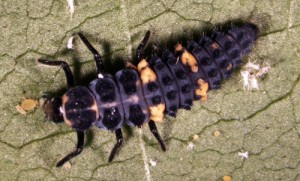
Third instar larvae of Hippodamia convergens. Photograph by Luis F. Aristizábal, University of Florida
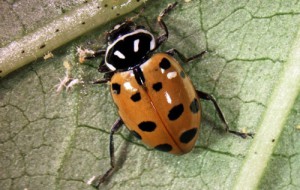
Newly emerged adult Hippodamia convergens showing typical body markings. Photograph by Luis F. Aristizábal, University of Florida.
Soldier Bug
A different but closely related species of the stink bug, this predator uses its piercing / sucking mouthparts to feed on larval beetles and caterpillars.
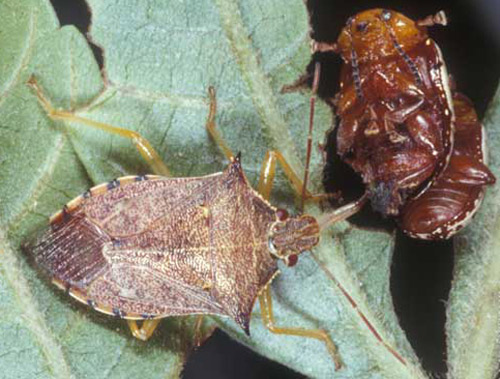
Dorsal view of an adult spined soldier bug, Podisus maculiventris (Say), feeding on a mating pair of sumac flea beetles, Blepharida rhois (Forster) (Coleoptera: Chrysomelidae). Photograph by Lyle J. Buss, University of Florida.
Lacewings
The green and brown lacewing is often found around aphid infestations. The larva is the major predator, they make the biggest dent on aphid populations. In addition to aphids, lacewings also feed on scale, mealybugs and several species of insect eggs.
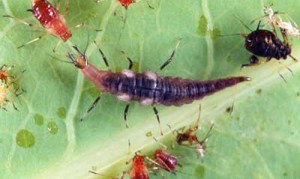
Larva of a brown lacewing (Neuroptera: Hemerobiidae) preparing to attack and feed on an aphid. The black-colored aphid to the right was probably parasitized by a wasp. Photograph by Lyle J. Buss, University of Florida.
Predatory Gall Midges
This aphid predator is easily overlooked because it is so small, and resembles the flower fly. They also feed on scale, thrips and mites.
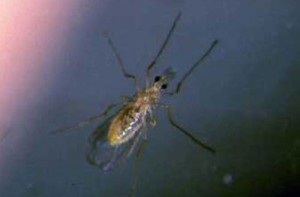
Adult of the predatory gall-midge, Feltiella acarisuga (Vallot). Photograph by David R. Gillespie, Agassiz.
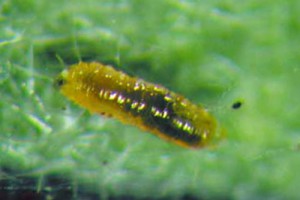
Larva of the predatory gall-midge, Feltiella acarisuga (Vallot). Photograph by Lance S. Osborne, University of Florida.
Flower Flies (Hover Flies)
Flower Flies actually resemble honeybees or bumblebees. People often run from them! The adult is an important pollinator for many crop species and feeds on nectar and aphid honeydew. This time it’s the larva which is predatory and is a voracious feeder of aphids. Large concentrations of larvae substantially reduce aphid populations in aphid infested gardens and fields.
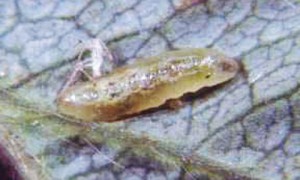
Larva of Allograpta obliqua (Say), a hover fly. Photograph by James F. Price, University of Florida.
Parasitic Flies
There are many types of parasitic flies which parasitize a variety of insect pest species. They may inject their eggs into the host, or lay the egg on the surface of their host. Usually they are very small and not noticeable.
Parasitic Wasps
Most parasitic wasp species are tiny, fast and hard to notice. The average gardener is not aware of their rather plentiful existence. They are a common killer of grubs, caterpillars, whiteflies and aphids. They either insert their eggs into the organism or lay eggs on the surface of their host.
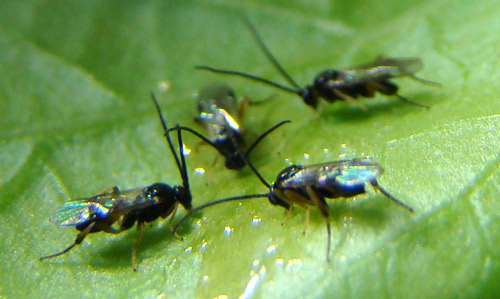
A group of adult Cotesia congregata (Say) wasps feeding on honey solution placed on the underside of a tomato leaf. Photograph by Justin Bredlau, Virginia Commonwealth University.
Big Eyed Bugs and Minute Pirate Bugs
While big eyed bugs and minute pirate bugs are not related, they perform similar functions in gardens and agricultural systems by feeding on chinch bug nymphs, psocids, leafhoppers, aphids, thrips, and mites. They are found in variety of ecosystems and do their job anonymously.
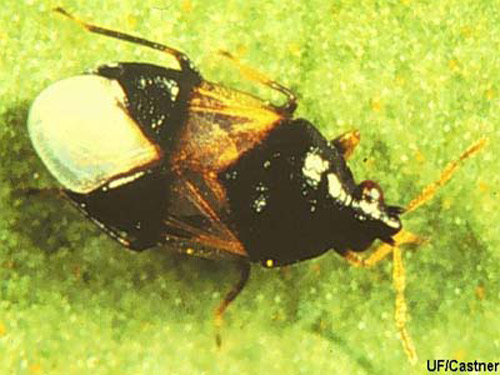
The minute pirate bugs are black with white markings. They prey on many small insects and eggs, including thrips. About 70 species exist in North America. Photograph by James Castner, University of Florida
References:
Natural Enemies and Biological Control. Publication #ENY-822
Featured Creatures. UF / IFAS Entomology and Nematology
EDIS: Beneficial Insects
- Woodland Pinkroot Adds Vibrant Color to Spring Landscapes - April 27, 2023
- Easy Care Roses for the Gulf South - April 20, 2023
- Herb Gardening: When Oregano is Flavorless - March 9, 2023

